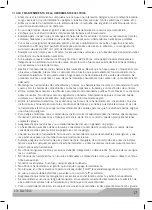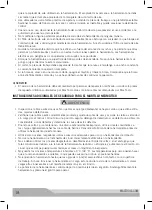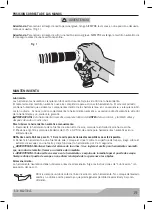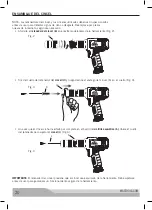
800.MACTOOLS
5
Wear fire-retardant clothing and have a bucket of water nearby.
• Direct the exhaust so as to minimize disturbance of dust in a dust-filled environment.
• Where dust or fumes are created, the priority shall be to control them at the point of emission.
• All integral features or accessories for the collection, extraction or suppression of airborne dust or fumes
should be correctly used and maintained in accordance with the manufacturer’s instructions.
• Select, maintain and replace the consumable/inserted tool as recommended in the instructions, to prevent
an unnecessary increase in dust or fumes.
• Always operate, inspect and maintain this tool in accordance with American National Standards Institute
Safety Code for Portable Air Tools (ANSI B186.1) and any other applicable safety codes and regulations.
3) POWER TOOL USE AND CARE
• Before running the tool, check that there is no dangerous interaction with the immediate environment
(explosive gas, flammable or dangerous liquid, unknown piping, electric sheathing or cable, etc).
• Before connecting the tool to the air inlet, check the trigger is not blocked in the on position by an obs-
tacle.
• In the event of blockage, release the trigger and disconnect the tool from the compressed air network.
• Ensure that the unit on which work is being carried out is immobilized.
• Always operate, inspect and maintain this tool in accordance with all regulations (local, state, federal and
country), that may apply to hand held/hand operated pneumatic tool.
• For safety, top performance, and maximum durability of parts, operate this tool at 90 psig.
(6.2 bar / 620 kPa) maximum air pressure at the inlet with 3/8’’ (10mm) inside diameter air supply hose.
• Always use clean, dry air. Dust, corrosive fumes and/or excessive moisture can ruin the motor of an air
tool.
• Exceeding the maximum pressure of 90 psig (6.2 bar / 620 kPa) will lead to the risk of danger such as
excessive speed, tool wear, breaking parts, higher torque or force that may destroy the tool and its acces-
sories or the part being worked on.
• Maintain power tools. Check for misalignment or binding of moving parts, breakage of parts and any other
condition that may affect the power tool’s operation. If damaged, have the power tool repaired before use.
Many accidents are caused by poorly maintained power tools.
• Keep cutting tools sharp and clean. Properly maintained cutting tools with sharp cutting edges are less
likely to bind and are easier to control.
• Use rated accessories recommended by Mac Tools only. Inspect accessories before use. Do not use crac-
ked or damaged accessories. Just because the accessory can be attached to your power tool, it does not
assure safe operation.
• Use the power tool, accessories and tool bits, etc. in accordance with these instructions, taking into ac-
count the working conditions and the work to be performed. Use of the power tool for operations different
from those intended could result in a hazardous situation.
• For multiple hazards, read and understand the safety instructions before installing, operating, repairing, main-
taining, changing accessories on, or working near the saw. Failure to do so can result in serious bodily injury.
• Ensure that sparks and debris resulting from use do not create a hazard.
• The pneumatic tool must be fitted and connected to the compressed air network via quick disconnects to
facilitate shutdown in the event of danger.
• When the life of the tool has expired, it is recommended that the tool be disassembled, degreased and
parts be separated by material so that they can be recycled.
• Always turn off the air supply and disconnect the air supply hose before installing, removing or adjusting
any accessory on this tool, or before performing any maintenance on this tool.
• Do not use damaged, frayed or deteriorated air hoses and fittings. Do not abuse hoses or connectors.
• Do not lubricate tools with flammable or volatile liquids such as kerosene, diesel or jet fuel.
• Do not remove any labels. Replace any damaged label.
• Do not use the tool if the trigger does not turn the tool on or off.
• Do not lock, tape or wire the "on/off" safety lever in the "on" position, as the lever must be free to return to
the "off" position when released.
• Be sure all hoses and fittings are the correct size and are tightly secured.






































